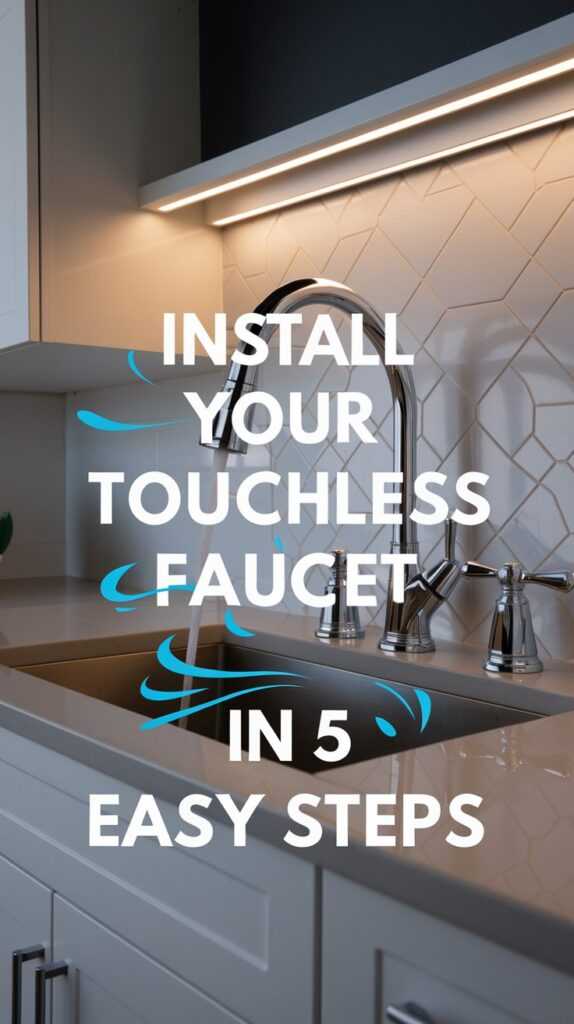Install a touchless faucet to enjoy hands-free convenience in your smart home. These faucets use motion sensors to detect movement.
This lets you turn the water on and off without touching the handle. It helps reduce germs, making your kitchen or bathroom cleaner.
Touchless faucets also save water by preventing waste. Many models offer adjustable temperature settings for comfort and safety.
You can install them easily with basic tools. Designed for modern living, they add a sleek look to any space.
Whether upgrading your home or embracing smart tech, a touchless faucet is a smart choice for convenience and cleanliness.
Turn Off Water Supply
Before starting any plumbing work, turn off the water supply. This step is key to preventing water damage and ensuring safety during installation.
Find the shut-off valve under the sink or at the main water line.
Turning off the water stops unexpected leaks or spills. This easy step can save you from water damage and help the installation go smoothly.
Test to make sure the water is completely off before you proceed.
After shutting off the water, release any remaining water from the faucet by turning it on.
This clears the pipes, making your installation cleaner and safer. Always double-check the shut-off valve to ensure it’s fully closed.
Remove Old Faucet
Before starting, turn off the water supply. This stops spills or flooding when you remove the old faucet. Check under the sink for the shut-off valves and turn them off fully.
Use a wrench to loosen the nuts that hold the old faucet. If they’re tight or rusted, spray on some penetrating oil. Once they’re loose, remove the nuts and lift the old faucet out.
Clean the sink area where the old faucet was. Remove old sealant and debris for a smooth installation of your new touchless faucet.
This helps create a good seal and prevents leaks later.
Install the New Faucet
To install a touchless faucet, first check that you have all parts and tools. Follow the included instructions closely for a smooth installation. Tighten all connections to prevent leaks.
Turn off the water supply before you start. This helps avoid accidental spills. Remove the old faucet carefully and clean the area before setting the new touchless faucet in place.
Once the faucet is positioned, connect the water lines and the power source, either batteries or a plug.
Test your new faucet by turning on the water supply. Make sure it works properly and is leak-free.
Connect the Power
Touchless faucets require electricity to operate. Depending on the model, you can use batteries or an AC adapter.
Follow the faucet’s instructions to connect the power source correctly.
When using batteries, select the right type and insert them as directed. Check and replace the batteries regularly to keep your faucet running smoothly.
If your faucet uses an AC adapter, locate a nearby power outlet. Plug in the provided adapter and ensure the connection is secure to prevent power interruptions.
Test the Faucet
After you install your touchless faucet, turn the water supply back on. Let the water run to check that everything works well.
Also, inspect all connections for leaks. Ensure the sensor activates the water flow correctly.
Next, test both hot and cold water settings. Make sure the temperature changes smoothly and that the water pressure is what you need.
If you see issues like uneven water flow or leaks, review the installation steps.
A loose connection or misaligned part might be the cause. Fix any problems before using the faucet regularly.
Conclusion
Installing a touchless faucet in your smart home is easy. It can boost convenience and hygiene in your kitchen or bathroom.
Follow our guide for hands-free operation. This will help reduce water waste and make your home smarter and more efficient.
What tools do I need to install a touchless faucet?
You’ll need a wrench, screwdriver, plumber’s tape, a bucket, and towels.
Why is it important to read the manufacturer’s instructions before installing a touchless faucet?
Each touchless faucet model has its own requirements. Knowing these details can help you avoid mistakes and ensure a smooth installation.
What should I do to manage unexpected water spills during installation?
Keep a bucket and towels nearby. They help manage spills, keep your workspace clean, and prevent water damage.
Why is turning off the water supply crucial before starting the installation?
Shutting off the water supply stops leaks or spills. It also keeps things safe during installation.
How do I ensure that the water is completely off before proceeding with the installation?
Find the shut-off valve and turn it off fully. Then, let any leftover water drain by turning on the faucet.
What should I do if the nuts holding the old faucet are too tight or rusted?
Applying some penetrating oil can help loosen the nuts.
Why is it important to clean the area around the sink after removing the old faucet?
To install your new touchless faucet smoothly, remove any old sealant or debris. This will help create a good seal and prevent future leaks.
What steps should I take to test the new touchless faucet after installation?
Turn the water supply back on. Let the water run to check proper operation. Look at all connections for leaks.
Ensure the sensor activates the water flow correctly. Test both hot and cold water settings.
How should I connect the power source for a touchless faucet?
Connect the power source as the faucet instructs. Use either batteries or an AC adapter. Make sure the connection is secure to prevent power interruptions.
What should I do if I notice inconsistent water flow or leaks after installation?
Check the installation steps for loose connections or misaligned parts. Fix any issues before using it regularly.

